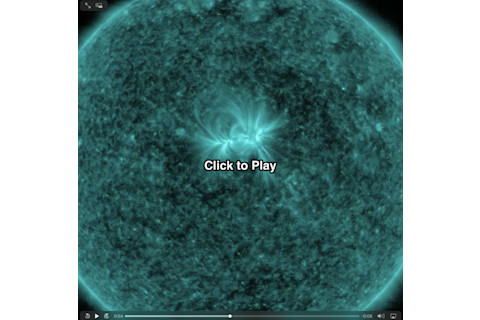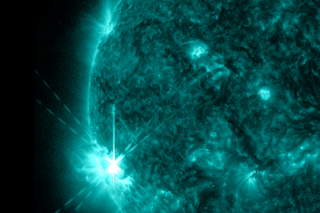A bright tangle of magnetic field lines has appeared on its surface. But otherwise the Sun is singularly serene. What's going on?

View of the Sun from NASA's Solar Dynamics Observatory The other day, NASA posted this closeup view of the Sun under the headline: "Tangled Up in Blue." The reference to the Bob Dylan tune aside, I found the video particularly intriguing. That's because the Sun's surface, as imaged here by the Solar Dynamics Observatory spacecraft, is actually quite placid. But there's one exception: a very bright active region, seen as a tangle of bright filaments tracing out magnetic field lines emerging from the Sun's surface. When the Sun is in a more active part of its 11-year cycle, you're likely to see more active regions like this. These are areas that roil with gargantuan filaments, loops, and prominences formed from unimaginably hot plasma levitated by magnetic fields. Sometimes, radiation will blast outwards from the Sun's surface. These solar flares, a million times more energetic than volcanic eruptions on Earth, often are accompanied by enormous explosions of plasma. Such coronal mass ejections, or CMEs, propel a billion tons of material outward at hundreds of miles per second. Yet here, the SDO spacecraft shows the Sun in a serene state — except for that one active region. Here's how NASA describes what we're looking at:
The lone active region visible on the sun put on a fine display with its tangled magnetic field lines swaying and twisting above it (Apr.24-26, 2018) when viewed in a wavelength of extreme ultraviolet light. The charged particles spinning along these field lines illuminate them. The region did not erupt with any significant solar storms, although it still might.
In addition to experiencing a dearth of filaments, loops, prominences, flares and ejections, the Sun has been going naked lately, losing all of its spots at times. As I pointed out in a post back in February:
Spotless periods . . . are common as the Sun approaches the low point in its 11-year solar cycle. We’re headed for that minimum next year.
The Sun reached a peak in activity during 2014. It turned out to be the weakest maximum in solar activity since 1906. Solar activity has since been declining and will soon bottom out. There are indications that this upcoming solar minimum could be particularly deep. The Sun’s 11-year cycles of rising and falling activity are usually fairly regular. But much longer variations can occur. One example, known as the Maunder Minimum, occurred between 1645 and 1715. During this period, the Sun experienced a very prolonged spell of low solar activity. According to recent research, a continuing decline in solar activity is occurring faster than any other in more than 9,300 years. This points toward a 15 to 20 percent chance of a return to conditions similar to the Maunder Minimum.
You'll often hear claims that if we head into a long-lasting period similar to that, it will help neutralize human-caused global warming. That's because the amount of solar radiation reaching Earth during low solar activity periods is reduced. But the research shows something else.
The Maunder Minimum was indeed associated with cold European winters. But it did not have as big an effect on the global climate overall.
Looking forward in time, studies suggest that an extended Maunder-Minimum-like period during this century would produce similar results — cold winters in Eurasia, but much less of a global impact.
Modeling shows that if emissions of climate-warming greenhouse gases continue unabated, temperatures could rise 4 degrees C above preindustrial levels by the end of the century. At the same time, several studies have shown that human-caused global warming would be offset by no more than about 0.2°C in the year 2100 by a Maunder-Minimum-like episode.





